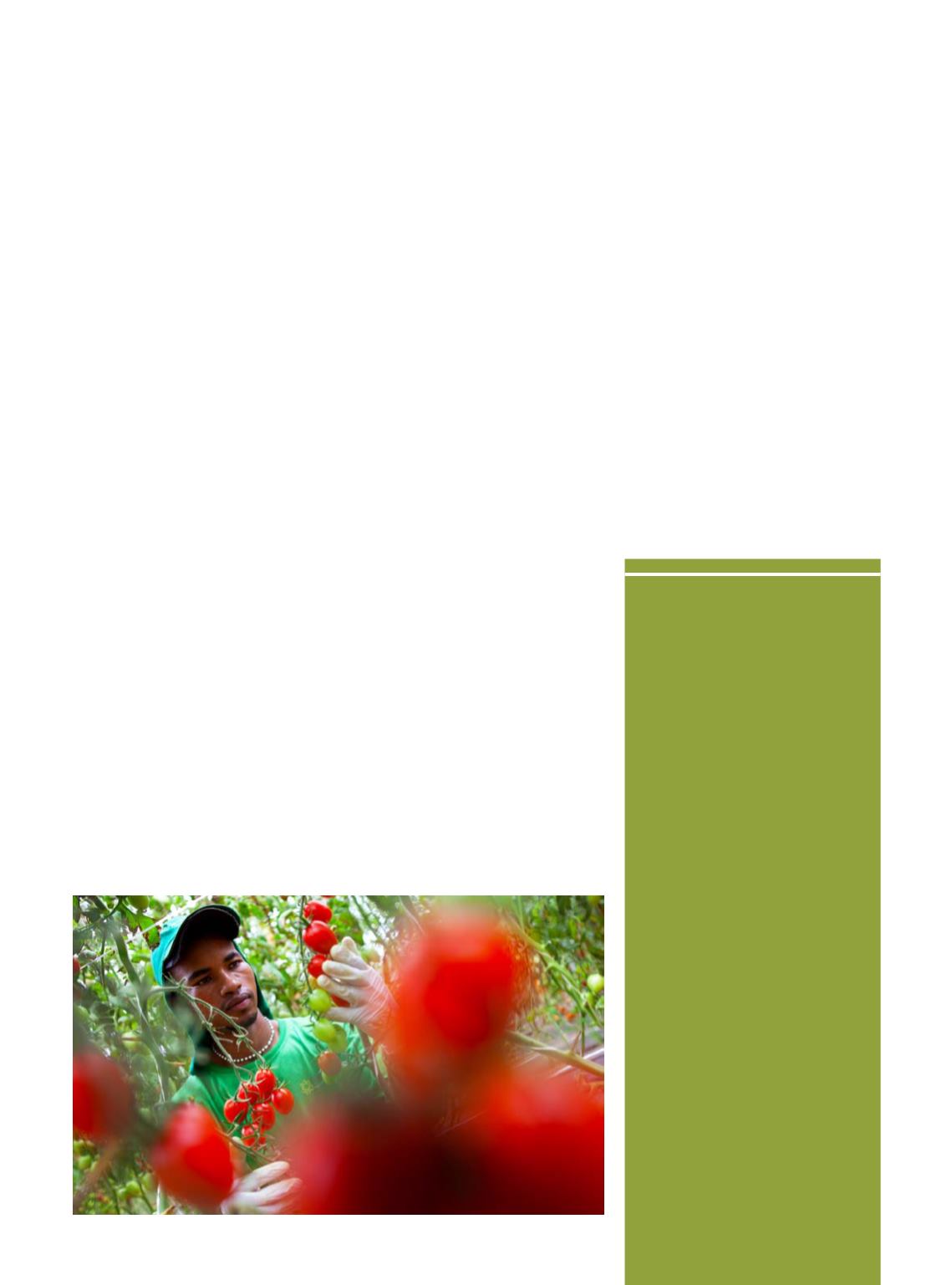
33
Although tomatoes are susceptible to
bad weather conditions and to disease and
pest outbreaks, the value they fetch tends to
make up for the risks. Of all products traded
at the São Paulo General Warehousing Com-
pany (Ceagesp), the fruit only comes sec-
ond to oranges in volume. However, when
it comes to values in circulation, tomatoes
are at the top of the list, and are referred to
as red gold by the farmers. Despite its high
value, the price of the vegetable fluctuates
quite a lot throughout the year, varying ac-
cording to climate conditions that call for
specific management practices, with direct
reflections on offer and demand.
According to agronomic engineer
Leonardo Boiteux, from Embrapa Veg-
etables, it is important for the farmers to
achieve profitable levels in order to cover
the high production costs of tomato farm-
ing. To produce one hectare of table toma-
toes, for example, production costs amount
to about R$ 50 thousand. The inputs, some
of them with dollarized prices, represent a
considerable chunk in these expenses, be-
sides pesticides, labor and the entire infra-
structure. Another relevant component in
the production cost is the seed itself, which
represents 10% of the total. “The new tech-
nology, of hybrid tomatoes, is rather ex-
pensive, as the seeds are manually collect-
ed, on behalf of quality”, he explains.
The researcher highlights that genetic
enhancement, through the accumulation
of positive genetic plant characteristics,
tries to reduce expenses, like the need for
labor, which represents a relevant weight
in the production cost – about R$ 12
thousand to R$ 50 thousand. “Producers
manage to reduce to nil the cost and start
making profits when they harvest, in gen-
eral, 400 boxes of tomatoes per one thou-
sand plants”, he reckons. Depending on
the market price, tomatoes are a better in-
vestment than any application on the stock
exchange, as profits are achieved in a short
period of time. In 240 days, the tomato
farmers have the money in their pockets,
but they need to face risks”, he ponders.
According to the holder of a Ph.D. in
plant genetics and enhancement, science
has also contributed towards more resis-
tant fruits that reach their destination intact,
without suffering damage during transpor-
tation. Before the arrival of hybrid toma-
toes, Santa Clara type tomatoes suffered
ORGANICS,
CONFIRMEDTREND
Although tomato plants are subject
to 200 types of known diseases, hybrid
technology has responded positively
to the supply chain in terms of genetic
resistance. The trend is for ever more
resistant varieties, where organic farm-
inghas itsway, too. A survey conducted
in the United States, in 2015, demon-
strates that the change in eating habits
is a one-way road, with people getting
more andmore concernedwithhealthy
foods, based on fruit and vegetables,
preferably grown organically.
Embrapa
Vegetables
researcher
Leonardo Boiteux maintains that if the
demands of these ever more discerning
consumers are to be met, there is need
to diversify the cultivars, and provide for
varietal groups that reach the different
market niches. “The growth of both or-
ganicandconventionalcropsdependson
genetic materials capable of facing some
limiting problems, like global warming
and its high temperatures, which could
impact severely on the pollen and reduce
the production of tomatoes”, he justifies.
With the evolution of researchworks, the
trend is for the red gold to turn out to be
the right choice for the farmers.
Red
gold
Valueofthefruit inducesthefarmerstobetontheactivity, despitethe
difficultiesfacedbythesupplychain, particularly, climateconditions
losses of upwards of 20%. In distances
from Brasília to Belém, for example, losses
could amount to 40%. “Genetically modi-
fied seeds result in quality for consumers,
although some genes negatively impact
upon the flavor. Therefore, the challenge
of genetic enhancement efforts consists in
coming up with new long life hybrid toma-
toes, able to endure long distance transpor-
tation, with an intense flavor that encourag-
es consumption”, Boiteaux notes.


